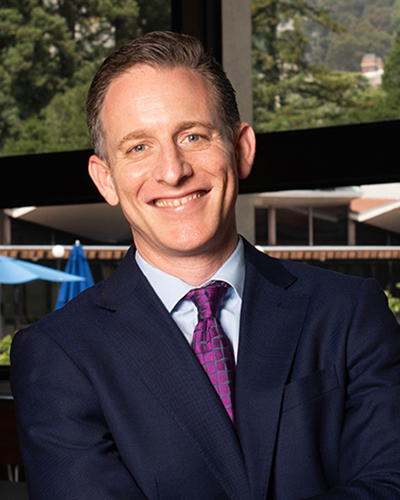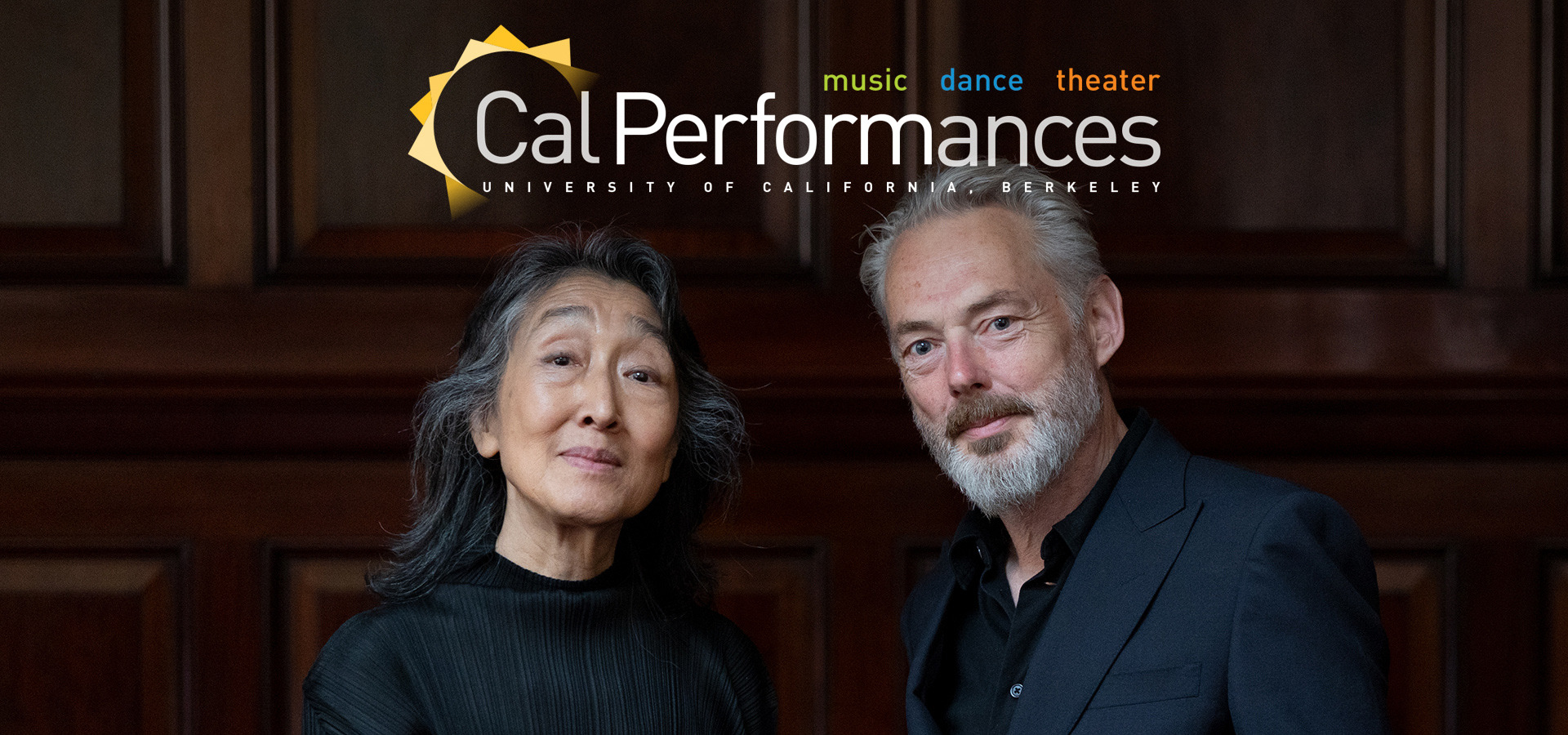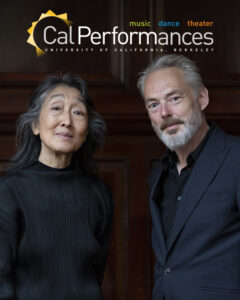Mark Padmore, tenor
Mitsuko Uchida, piano
Sunday, March 17, 2024, 3pm
Hertz Hall
Please hold your applause until the end of the program.
This performance is made possible, in part, by an anonymous Patron Sponsor.
Cal Performances is committed to fostering a welcoming, inclusive, and safe environment for all—one that honors our venues as places of respite, openness, and respect. Please see the Community Agreements section on our Policies page for more information.
This program will last approximately 70 minutes and be performed without intermission.
From the Executive and Artistic Director

We continue our extraordinary 2023–24 season with a schedule of performances that would be the envy of any performing arts presenter in the nation. I’m especially proud that the legendary pianist Mitsuko Uchida will return to campus this month as Artist in Residence, for two special concerts—March 17 with tenor Mark Padmore in Schubert’s song cycle Winterreise, and March 24 with the acclaimed Mahler Chamber Orchestra in piano concertos by Mozart and an orchestral work by Jörg Widmann—as well as additional opportunities for the campus and wider Bay Area community to engage with her singular artistry. We are also very excited to welcome the return of one of the crown jewels in American dance, The Joffrey Ballet, which this year celebrates the renewal of a multi-season residency at Cal Performances with its first full-length narrative ballet, Anna Karenina, at Zellerbach Hall (Mar 15–17).
The iconic Elevator Repair Service theater company visits from New York with Baldwin and Buckley at Cambridge (Mar 1–3), its lean and elegant production about a historic 1965 debate between the progressive queer Black writer and activist James Baldwin and the “Father of American Conservatism,” William F. Buckley, Jr. And, the Bay Area’s beloved Kronos Quartet celebrates its 50th year of reinventing the string quartet for our global, connected, contemporary world with a special concert featuring a world premiere commissioned from Indonesian composer Peni Candra Rini, who will join the Kronos members onstage as a performer (Mar 2).
We’ll enjoy an artfully curated program by the brilliant young pianist Conrad Tao (Mar 3); the Cal Performances debut of a particularly exciting young string ensemble, the Isidore String Quartet (Mar 5); and the West Coast premiere of Ki moun ou ye (Who are you?), an immersive staged song cycle by composer, flutist, and vocalist Nathalie Joachim (Mar 7). Joachim’s piece is set on the remote Caribbean farmland where her family has lived for generations, and travels deeper into the Haitian heritage introduced on her Grammy-nominated Fanm d’Ayiti recording.
In other genres, the June Award-winning group OKAN demonstrates what can happen when you take a classically trained percussionist from Santiago de Cuba, add a one-time concertmaster from Havana’s Youth Orchestra, and stir in the sounds of Caribbean folkloric and dance music in the context of Toronto’s vibrant immigrant music community (Mar 8); and Wild Up, the dazzling Los Angeles contemporary music collective, reminds us how new a 50-year-old music score can sound with its presentation of Julius Eastman’s ecstatic, jubilant, and hypnotic Femenine. And finally, we can’t wait for the Cal Performances debut of Ema Nikolovska, a young mezzo-soprano on the rise and in demand in international opera houses and concert halls; born in North Macedonia, raised in Toronto, and based in Europe, Nikolovska visits with a program featuring songs by Schubert, Richard Strauss, and Debussy.
Even as all these remarkable performances take place on the UC Berkeley campus, the Cal Performances team is hard at work planning for the mid-April announcement of our 2024–25 season. Trust me when I promise that we have a truly exceptional schedule planned for you, an example of which was last month’s sneak-peak announcement of the Maria Manetti Shrem and Elizabeth Segerstrom California Orchestra Residency, when Cal Performances and the Philharmonic Society of Orange County will bring the world renowned Vienna Philharmonic, conductor Yannick Nézet-Séguin, and pianist Yefim Bronfman to California in March 2025.
Finally, thank you for joining us today at Cal Performances! We’re delighted to spend this time together, celebrating the very best in live music, dance, and theater.
Jeremy Geffen
Executive and Artistic Director, Cal Performances
 We continue our extraordinary 2023–24 season with a schedule of performances that would be the envy of any performing arts presenter in the nation. I’m especially proud that the legendary pianist Mitsuko Uchida will return to campus this month as Artist in Residence, for two special concerts—March 17 with tenor Mark Padmore in Schubert’s song cycle Winterreise, and March 24 with the acclaimed Mahler Chamber Orchestra in piano concertos by Mozart and an orchestral work by Jörg Widmann—as well as additional opportunities for the campus and wider Bay Area community to engage with her singular artistry. We are also very excited to welcome the return of one of the crown jewels in American dance, The Joffrey Ballet, which this year celebrates the renewal of a multi-season residency at Cal Performances with its first full-length narrative ballet, Anna Karenina, at Zellerbach Hall (Mar 15–17).
We continue our extraordinary 2023–24 season with a schedule of performances that would be the envy of any performing arts presenter in the nation. I’m especially proud that the legendary pianist Mitsuko Uchida will return to campus this month as Artist in Residence, for two special concerts—March 17 with tenor Mark Padmore in Schubert’s song cycle Winterreise, and March 24 with the acclaimed Mahler Chamber Orchestra in piano concertos by Mozart and an orchestral work by Jörg Widmann—as well as additional opportunities for the campus and wider Bay Area community to engage with her singular artistry. We are also very excited to welcome the return of one of the crown jewels in American dance, The Joffrey Ballet, which this year celebrates the renewal of a multi-season residency at Cal Performances with its first full-length narrative ballet, Anna Karenina, at Zellerbach Hall (Mar 15–17).
The iconic Elevator Repair Service theater company visits from New York with Baldwin and Buckley at Cambridge (Mar 1–3), its lean and elegant production about a historic 1965 debate between the progressive queer Black writer and activist James Baldwin and the “Father of American Conservatism,” William F. Buckley, Jr. And, the Bay Area’s beloved Kronos Quartet celebrates its 50th year of reinventing the string quartet for our global, connected, contemporary world with a special concert featuring a world premiere commissioned from Indonesian composer Peni Candra Rini, who will join the Kronos members onstage as a performer (Mar 2).
We’ll enjoy an artfully curated program by the brilliant young pianist Conrad Tao (Mar 3); the Cal Performances debut of a particularly exciting young string ensemble, the Isidore String Quartet (Mar 5); and the West Coast premiere of Ki moun ou ye (Who are you?), an immersive staged song cycle by composer, flutist, and vocalist Nathalie Joachim (Mar 7). Joachim’s piece is set on the remote Caribbean farmland where her family has lived for generations, and travels deeper into the Haitian heritage introduced on her Grammy-nominated Fanm d’Ayiti recording.
In other genres, the June Award-winning group OKAN demonstrates what can happen when you take a classically trained percussionist from Santiago de Cuba, add a one-time concertmaster from Havana’s Youth Orchestra, and stir in the sounds of Caribbean folkloric and dance music in the context of Toronto’s vibrant immigrant music community (Mar 8); and Wild Up, the dazzling Los Angeles contemporary music collective, reminds us how new a 50-year-old music score can sound with its presentation of Julius Eastman’s ecstatic, jubilant, and hypnotic Femenine. And finally, we can’t wait for the Cal Performances debut of Ema Nikolovska, a young mezzo-soprano on the rise and in demand in international opera houses and concert halls; born in North Macedonia, raised in Toronto, and based in Europe, Nikolovska visits with a program featuring songs by Schubert, Richard Strauss, and Debussy.
Even as all these remarkable performances take place on the UC Berkeley campus, the Cal Performances team is hard at work planning for the mid-April announcement of our 2024–25 season. Trust me when I promise that we have a truly exceptional schedule planned for you, an example of which was last month’s sneak-peak announcement of the Maria Manetti Shrem and Elizabeth Segerstrom California Orchestra Residency, when Cal Performances and the Philharmonic Society of Orange County will bring the world renowned Vienna Philharmonic, conductor Yannick Nézet-Séguin, and pianist Yefim Bronfman to California in March 2025.
Finally, thank you for joining us today at Cal Performances! We’re delighted to spend this time together, celebrating the very best in live music, dance, and theater.
Jeremy Geffen
Executive and Artistic Director, Cal Performances
About the Program
Franz Peter Schubert was born in Liechtental, a suburb of Vienna, on January 31, 1797, and died in Vienna on November 19, 1828. He composed the song cycle Winterreise in two parts (of 12 songs each), set to 24 poems by Wilhelm Müller. Schubert composed part one in February 1827 and part two in October of that year. The two parts were also published separately by Tobias Haslinger—the first on January 14, 1828, and the second on December 30, 1828. Winterreise is scored for voice and piano.
WINTERREISE
There is no one who understands the pain or the joy of others! We always imagine we are coming together, and we always merely go side by side. Oh what torture for those who recognize this!
—from Franz Schubert’s journal, quoted in Schubert: The Final Years
by John Reed
Winterreise, a cycle of 24 songs by Franz Schubert, is one of the miracles of Western music. Schubert had perfected the art song, the lied, as a musical form. He developed the narrative song cycle with Die schöne Müllerin of 1823, and, four years later, with Winterreise. (Schwanengesang, which appeared after Schubert’s death, was not intended by the composer to be a cycle; it was created by his publisher from various unpublished songs.)
Die schöne Müllerin marked the first time a composer had linked several distinctly separate songs to tell a continuous story—a sad story, to be sure. By the time Schubert wrote Winterreise, he was able to plumb despair and convey tragedy to such an extent that the cycle as a whole achieves an emotional impact far beyond that of the individual songs. The cumulative effect Winterreise can have on a listener is perhaps closer to Schoenberg’s 1909 monodrama Erwartung than it is to its sister cycle, Die schöne Müllerin.
The fact that Winterreise deals with alienation and death in such a new and unrelenting way, coupled with Schubert’s tragic death at 31, only a year after he completed the work, has caused some to see a direct correlation between the composer’s life and work: the impoverished, unrecognized genius foretelling his own death by writing these bleak, despairing songs. But trying to read such meaning into Winterreise trivializes it, and we have no evidence that Schubert thought of these songs as a farewell to life. It is true that he corrected printer’s proofs of the second half of Winterreise on his deathbed, but the last song he composed was either the cheerful, bucolic “Der Hirt auf dem Felsen” (“The Shepherd on the Rock”) or the hopeful, yearning “Die Taubenpost” (“The Carrier-Pigeon Mail,” the closing song of Schwanengesang), and both songs are a universe away from Winterreise. The final instrumental work Schubert composed was his astonishing String Quintet in C major (D. 956), a profound work of almost painful beauty, but lacking in the despair and angst that permeate Winterreise.
Schubert has been criticized for lavishing his astonishing lyric gifts on the works of minor poets—including Wilhelm Müller, whose work provided the basis for both Die schöne Müllerin and Winterreise. But Müller’s poems struck an extraordinarily responsive chord in Schubert. What served the composer so well in Müller was the directness and immediacy of the emotion, the vividness of the images, the naturalness of the language, and its inherent lyricism and simplicity. The poems themselves seem to sing, which is no accident.
“I can neither play nor sing, yet when I write verses, I sing and play after all,” Müller once remarked. Later he wrote to a composer who had set some of his poetry. “My songs lead but half a life, a paper existence of black-and-white, until music breathes life into them, or at least calls it forth and awakens it if it is already dormant in them.”
Still, one wonders if even such a musically inclined poet as Wilhelm Müller realized there was such profoundly disturbing music in his Winterreise poems as Schubert found. (Müller died in 1827 at 34, apparently without ever hearing any of Schubert’s settings of his poetry.)
Müller’s 24 poems were published in three installments. The first 12 appeared in 1823, in a Leipzig publication, Urania: Taschenbuch auf das Jahr 1823. Schubert discovered the poems, either in late 1826 or early in January 1827, because by February he had completed his settings. It was only several months later, in the summer of 1827, that he discovered there were more Winterreise poems than the 12 he had already set. Ten additional poems had been published in 1823; in 1824, with the addition of two more poems (“Die Post” and “Täuschung”), all 24 had been collected and published in Waldhornisten II. In that final form, Müller had changed the order of his poems, so they are not in the same sequence as they appear in Schubert’s cycle (though both Müller and Schubert open with “Gute Nacht” and close with “Der Leiermann”).
In the 1850s, a friend of the composer, Josef von Spaun, recalled the time those around Schubert first heard Winterreise: “For some time Schubert appeared very upset and melancholy. When I asked him what was troubling him, he would only say, ‘Soon you will hear and understand.’ One day he said to me, ‘Come over to Schober’s today [at the time, Schubert was sharing lodgings with his friend Franz von Schober] and I will sing you a cycle of horrifying songs. I am anxious to know what you will say about them. They have cost me more effort than any of my other songs.’ So he sang the entire Winterreise through to us in a voice full of emotion. We were utterly dumbfounded by the mournful, gloomy tone of these songs, and Schober said that only one, ‘Der Lindenbaum,’ had appealed to him. To this Schubert replied, ‘I like these songs more than all the rest, and you will come to like them as well.’ And he was right. . . . ”
The “dumbfounded” reaction of Schubert’s friends at first hearing Winterreise is not surprising. The more carefully we listen to the cycle, the more profoundly Winterreise moves us. Accustomed as we are today to the sounds of composers such as Berg and Schoenberg, we may not hear immediate screams of alienation or despair in Schubert’s music. But within his own musical vocabulary, he delineates dark emotions vividly—even horrifyingly. And the emotions are the stronger for the apparent simplicity of the settings.
W.H. Auden pointed out that “Some of the best things in late works come not in climaxes, but in bridge passages, in little points. Their virtues are virtues for the real connoisseur, they’re not immediately apparent.” That is especially true in Winterreise, given Schubert’s tuneful musical language. The depth of feeling and lack of sentimentality to which Dietrich Fischer-Dieskau has referred is often conveyed most vividly by those “little points” and “bridge passages.” A good example appears in the first song, “Gute Nacht.” As might be expected of such a sad song, it is set in a minor key (D minor.) But after three verses in D minor, Schubert suddenly—and unexpectedly—shifts to D major for the final verse. Somehow Schubert makes this major tonality sound even sadder than its minor counterpart, and the final verse, with its leave-taking of the narrator’s beloved, is almost unbearably poignant.
Throughout the cycle, Schubert and Müller use many of the images dear to the hearts of German early-Romantics: the idea of wandering, the narrator’s identification of his emotions with nature, the intense feeling of being alone and of rejection in love. What is so new about these elements in Winterreise is their unrelenting starkness and brutality. At the end of Die schöne Müllerin, there is a sweetness, a comfort in the idea of death. In Winterreise, death, though longed for, is denied. The narrator is condemned to wander through a cold, barren landscape. The houses he passes are shuttered; neither their warmth nor their comfortable beds are for him. Even the graveyard rejects him, leaving him no choice but to continue his bleak, endless wandering.
At the end of the cycle, in the song “Der Leiermann,” the narrator meets another person, an organ grinder, who stands “barefoot on the ice,” grinding away on his hurdy-gurdy, ignored by everyone except the snarling dogs. The constant droning open fifths Schubert writes for the pianist’s left hand in the accompaniment not only represent the droning of the hurdy-gurdy, they also convey how stuck, how trapped he is, and the repetitive, hopeless nature of existence. The sparseness of the music Schubert writes over the repetitive open fifths in the bass and the song’s apparent simplicity adds to its cumulative terror as the narrator asks the organ grinder, “Shall I go with you?” Is the organ grinder a figment of the narrator’s imagination? Is he Death? Madness?
“‘Der Leiermann’ is not only the emotional nadir of the cycle,” writes Fischer-Dieskau, “this song is the culmination of everything that Schubert ever wrote, for there is no escape from this agony.”
—Paul Thomason
The late Paul Thomason, a noted writer on opera and singers, wrote for the Metropolitan Opera and many other musical organizations. This essay appeared originally in the program book of the San Francisco Symphony and is reprinted by permission. Copyright © 2013 San Francisco Symphony.



